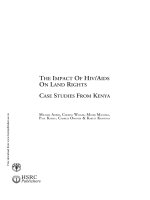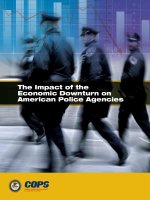The impact of servicescape on customer behavioral intention a study of apartment leasing service in HCMC
Bạn đang xem bản rút gọn của tài liệu. Xem và tải ngay bản đầy đủ của tài liệu tại đây (733.28 KB, 57 trang )
UNIVERSITY OF ECONOMICS HO CHI MINH CITY
International School of Business
------------------------------
Phan Thi Tuyen
THE IMPACT OF SERVICESCAPE ON CUSTOMER BEHAVIORAL
INTENTION: A STUDY OF APARTMENT LEASING SERVICE IN HCMC
MASTER OF BUSINESS (Honors)
Ho Chi Minh City – Year 2016
UNIVERSITY OF ECONOMICS HO CHI MINH CITY
International School of Business
------------------------------
Phan Thi Tuyen
THE IMPACT OF SERVICESCAPE ON CUSTOMER BEHAVIORAL
INTENTION: A STUDY OF APARTMENT LEASING SERVICE IN HCMC
ID: 22140062
MASTER OF BUSINESS (Honors)
SUPERVISOR: Dr. PHAM NGOC THUY
Ho Chi Minh City – Year 2016
1
Acknowledgement
I would like to express my deepest gratitude to ISB’s committee members, to my
supervisor, Dr. Pham Ngoc Thuy who have been supportive every step of this
research. Dr. Pham Ngoc Thuy helped me pursue the route and the topics of my
interests and made the whole process enjoyable. She gave me guidance with details
when I encountered problems. She gave words of encouragement and showed
tremendous understanding when I couldn’t break through. Her knowledge and
experience helped me set the course and made it possible for me to continue my
research.
I also would like to send many thanks to my family who motivate me a lot
during research period, to my clients, my friends and colleagues who participated in
the interview and survey for this research. They also gave me useful thoughts and
comments on my research. Their contributions make my research possible.
2
Abstract
This study examines the relationship between every aspect of servicescape, service
experience evaluation, and customer behavioral intentions. Based on data derived
from 304 customers who have leased apartments in Ho Chi Minh City (HCMC), a link
was found between both the substantive and communicative aspects of the
servicescape reliably predicted customers’ evaluations. This research also found that a
more favorable service experience evaluation positively related to behavioral
intentions. Theoretical contributions of this research are elucidated. Moreover,
managerial implications related to servicescape design, promotion strategies and
service experience enhancement are discussed.
Keywords
Servicescape, substantive staging of servicescape, communicative staging of
servicescape, customer behavioral intentions, leasing service, service experience
evaluation.
3
TABLE OF CONTENTS
ACKNOWLEDGEMENT
ABSTRACT
TABLE OF CONTENTS
LIST OF FIGURES
LIST OF TABLES
1. Introduction ........................................................................................................... 6
2. Literature review ................................................................................................... 9
2.1. Apartment Leasing Service in condominiums ..................................................... 9
2.2. Servicescape ....................................................................................................... 9
2.2.1. Substantive Staging of Servicescape ............................................................... 11
2.2.2. Communicative Staging of Servicescape......................................................... 13
2.3. Service experience evaluation ............................................................................ 14
2.2. Behavioral intentions ......................................................................................... 16
3. Method ................................................................................................................. 17
3.1. Procedure and sampling ..................................................................................... 17
3.2. Measurement scales ........................................................................................... 20
4. Data analysis and results ....................................................................................... 23
4.1. Measurement validation ..................................................................................... 23
4.2. Confirmatory Factor Analysis (CFA) ................................................................. 25
4.3. Hypotheses testing ............................................................................................. 30
4.4. Structural equation model (SEM) results............................................................ 31
5. Discussions ........................................................................................................... 33
4
5.1. Implications ....................................................................................................... 34
5.2. Conclusion ......................................................................................................... 35
5.3. Limitations and recommendations for future research ........................................ 36
6. Support information .............................................................................................. 37
6.1. Result of pilot research ...................................................................................... 37
6.2. Questionnaire..................................................................................................... 40
REFERENCES
APPENDIX
5
LIST OF FIGURES
Figure 1: Conceptual model ...................................................................................... 17
Figure 2: CFA result ................................................................................................. 27
Figure 3: SEM result................................................................................................. 32
LIST OF TABLES
Table 1: Descriptive statistics of sample ................................................................... 20
Table 2: Measurement scales .................................................................................... 22
Table 3: Comparison between CFA threshold values and CFA results ...................... 26
Table 4: Measurement scale validity and reliability testing result ............................. 29
Table 5: Means, standard deviations, and standardized CFA loadings of items ......... 29
Table 6: Structural paths in the model ....................................................................... 31
Table 7: Findings of pilot research ............................................................................ 37
Table 8: The respondent’s nationality ....................................................................... 40
Table 9: The name of condominiums ........................................................................ 41
6
1. Introduction
Bitner (1992) introduced the concept of "servicescape" as combination of service and
landscape that denotes the physical and mental environment in which customer
experiences are created. Servicescape is where a service provider provide services to
its customers. Servicescape is not only a cue for the expected service quality, but also
influences customers' evaluations of other factors determining perceived service
quality (Reimer & Kuehn, 2005). Nilsson and Ballantyne, 2014 stated that a
servicescape does not simply impact customer perceptions of service functions and
service quality, but more subtly, also impacts on the meanings a customer draws from
a lot of intangible, contextual and symbolic elements of a service. Servicescape or
atmospherics have the means of providing the evidence that assists consumers in
making subjective evaluations of service products (Hoffman & Turley, 2002).
Therefore, servicescape has a direct and an indirect effect on perceived service
quality, but different from service quality, servicescape has a high overall effect.
Servicescape has well developed theory which have been successfully tested in
many service contexts such as leisure service setting (Wakefield & Blodgett, 1996),
hotel industry (Countryman & Jang, 2006), retail service (Hooper et al, 2013), theme
park service (Dong & Siu, 2013), etc. Moreover, numerous studies have highlighted
various aspects of servicescape, such as color and light, background music, as well as
odors (Reimer & Kuehn, 2005). In Vietnam, some master theses studied about the
effect of servicescape to customer loyalty in restaurants or in coffee shop. However,
servicescape of apartment leasing service in condominiums has not been paid
adequate attention.
7
Leasing service is a common service in condominiums or residential buildings
requiring a large amount of capital of investors. It is not a high risk investment but it
can be a high return investment if the investors buy the right properties. In the world,
roundly 40% of population lives in rental housing (Malpezzi, as cited in Amenyah &
Fletcher, 2013). In Ho Chi Minh City (HCMC), recently, a large number of
condominiums came into the market. In 2015, the total supply was approximately
4,370 apartments from 83 projects, increasing 6% year-on-year (YoY). From 2016 to
2018, more than 67,000 units are expected to enter the market which providing around
2,200 apartments for leasing (Savills, Ho Chi Minh City Market Brief Q1 2016). With
a high gross domestic product (GDP) growth rate and being considered as the most
dynamic city in Viet Nam, in 2015, Ho Chi Minh City attracted US$3 billion in
foreign direct investment (FDI), up 129% (YoY). Increasing FDI inflow has
positively affected the demand for leasing apartments. The increasing of supply and
demand is a phenomenon creating a dynamic leasing apartment market.
Nevertheless, the rapid increasing in supply of leasing apartment service in the
coming years pushes the competition among investors, developers more and more
intense. The lessees nowadays have strong bargaining position due to many choices of
leasing apartments. Furthermore, the requirements of the lessees to have a stable
residence is more and more stringent. They do not only require to have a nice interior
decoration, high quality home appliances and furniture, etc. which are provided inside
the apartment, they also require to have a beautiful view, peaceful and clean area,
good facilities, fresh air, or how people manage the condominium, how safe and
security it is, etc. which are related to the landscape of service or the physical and
8
mental environment. Generally, location, surrounding development and scenic beauty
are common determinants of the demand for condominium properties (Zarin &
Bujang, 1999). The lessees normally prefers leasing apartment in condominiums to
other types of property due to the rental, convenience, safety, environment, location,
etc. The lessors who invest for leasing service normally look for long term lease
contracts and premium rentals leading to profitable investments. Accordingly, to meet
those requirements and encourage lessees to continue using service, the developers as
well as lessors need to build their properties with attractive servicescape to have more
competitive advantages. Servicescape is considered as future’s form of intense
competition in service environment (Ishaq, Bhutta, Hamayun, Danish & Hussain,
1995). Miles, Miles and Cannon (2012) state that servicescape is a part of competitive
approach that should be promoted and emphasized. For those reasons, this paper
contributes to the literature on servicescape by examining the impact of Servicescape
on behavioral intentions of leasing service in HCMC. To be more specific, this paper
is armed to examine:
-
The relationships between substantive staging and communicative
staging of servicescape and service experience evaluation of customers leasing
apartments in HCMC
-
The relationship between customers’ service experience evaluation and
their behavioral intention to continue using apartment leasing service
9
2. Literature review
2.1. Overview of apartment leasing service in condominiums
A condominium is a building or a structure which has two or more stories consisting
of parcels, owned and/or used separately by individuals and remaining portion of the
property being owned by the owners of individual unit in common (Gajanayake, as
cited in Ariyawansa & Udayanthika, 2012). There are low-rise condominium with
below five stories, medium-rise condominium with between six- to twelve-stories and
high-rise condominium including cluster of buildings over thirteen stories or above
(Ngai-ming Yip, Chin-oh & Tzu-ying Hung, 2007). The servicescape in
condominium refers to exterior attributes (such as building exterior, signage, parking,
waiting areas, admission office, and landscape), interior attributes (such as design,
layout, equipment and decoration), ambient conditions (such as the music and
temperature) and the people who work for providing the service (such as
administrators, receptionists, security guard, cleaners…). Over the years, researchers
focused more on lessees’ satisfaction in specific settings. Some studied property
specific characteristics such as high-rise, multifamily, or owner-occupied and others
focused on characteristics of neighborhood and environment, e.g. schools, climate, or
transportation (Brouwer, 2015). Brouwer (2015) also mentioned that the constructs of
leasing service is quite different from other services, services in leasing apartment
may be better expressed using variables related to maintenance and cleanliness.
2.2. Servicescape
Although the term “servicescape” is probably the most popular term to refer to the
influence of tangible and intangible cues on consumers, the other terms
10
“atmospherics”, “environmental psychology”, “store environments” and “physical
environment” also describe the same concept (Hooper et al, 2013). Significance of
servicescape depends on length of time customer spend for service and the purpose of
service consumption (hedonic or utilitarian) (Wakefield & Blodgett, 1994). The
physical environment may be an important determinant of customer satisfaction and
subsequent behavior when services are consumed primarily for hedonic purposes. The
relationship between the environmental stimuli (servicescape) and customer
behavioral intentions was first established by the environmental psychologists
(Russell & Mehrabian, 1974). Kotler (1973) used the term “atmospherics” to test if
the physical environment had an effect on human behavior. Psychologists have
determined that the physical environment has an effect on human behavior and this
branch of psychology has been known as environmental psychology.
Kotler (1973) pointed out that the physical environment in which a product is
purchased is an important part of the total consumption package. In 1974, Mehrabian
and Russell described environmental psychology as “the direct impact of physical
stimuli on human emotions and the effect of physical stimuli on a variety of
behaviors, such as work performance or social interaction”. In 1992, Bitner developed
atmospherics further by creating a conceptual framework for service settings and
began using the term servicescape to describe the physical environment in which
services occur. Bitner’s conceptual framework which is used in numerous researches
is comprised of the three environmental dimensions:
1. ambient conditions (i.e. weather, temperature, air quality, noise, music,
odors);
11
2. spatial layout and functionality (i.e. the way in which equipment and
furnishings are arranged, and the ability of those items to facilitate
consumers' enjoyment); and
3. Signs, symbols and artefacts (i.e. signage and decor used to communicate
and enhance a certain image or mood, or to direct customers to desired
destinations).
Arnould, Price and Tierney (1998) states a more comprehensive definition of
servicescape. According to Arnould et al., servicescape is like nested product of
managerial strategies and customer inputs. It was produced through substantive and
communicative staging, and can have high or low level of substantive staging
combined with either high or low levels of communicative staging. The substantive
staging of servicescape refers to the physical creation of contrived environment which
was stressed in most of previous related researches. The communicative staging of
servicescape refers to the ways in which environment is presented or interpreted. This
paper adopts the definition of Arnould et al. (1998) which describes fairy well the
servicescape at condominiums.
2.2.1. Substantive staging of servicescape
Substantive staging refers to “the physical creation of contrived environments”
(Arnould et al., 1998). Some services require a simple servicescape with a few
elements and spaces such as self-service (only customer) or remote service (only
employee), some others require complex servicescape and a lot spaces which interact
both customers and employees such as interpersonal services (Bitner, 1992).
12
Apartment leasing service is one of interpersonal services because it takes place in
condominiums with many floors, apartments, gardens, facilities and equipment, etc.
The substantive staging of servicescape is highlighted by Bitner in the research of
service marketing becomes a popular theory of servicescape.
The implications of previous research suggests that organizations need to be
acutely aware of how they manage a wide range of internal design issues because they
appear to affect the perceptions, emotional state and behavioral intentions of both
employees and customers. Over the years, the different studies have been conducted in
different industries. In 2002, Hoffman and Turley (2002) emphasize that both tangible
elements (the building, carpeting, fixtures, and point of-purchase decorations) and
intangible elements (colors, music, temperature, and scents) are essential in creating
service experiences. In 2006, Countryman and Jang has a study of hotel industry
stating that servicescape has a significant relationship to customers’ impression of the
hotel lobby. Recently, in the context of them park, Dong and Siu (2013) confirm that
visitors satisfy with the substantive staging of a servicescape positively relates their
service experience evaluation. Similarly, in the context of apartment leasing service,
the servicescape influence customer experience with the same direction as customer
using hotel service, theme park service, etc. Therefore, hypothesis 1 is proposed:
H1: Substantive staging of a servicescape is positively related to service
experience evaluation of customer using apartment leasing service.
13
2.2.2. Communicative Staging of Servicescape
Communicative staging of the servicescape refers to how the service environment is
presented and interpreted. It involves the transmission both of meaning directly related
to service delivery and of meaning transcending the instrumental context (Arnould et
al., 1998). Communicative staging of servicescape involves the transmission of
servicescape meaning and moves servicescape meaning from service provider to
customer, between customers and potentially at least from customers to providers.
According to Arnould et al. (1998), “Communicative staging is patterned through the
who, what, how and when of communication”. Service providers and customer
interactions are one of important ingredient of Communicative Staging and it is the
primary source of competitive differentiation. Bitner (1992) acknowledged though her
focus was to conceptualize the manufactured and physical stimuli that constitute
servicescape, both customers and employees are also affected by social and natural
stimuli, which are also housed within servicescape (Rosenbaum & Massiah, 2011).
Communicative staging includes the personnel and cultural elements of a
service setting. When the customers enter a service, they sometimes read the signs, the
announcement or ask the employees for help or explanations… The personnel aspects,
as service employees serve as the major channel for communication with customers,
they play an important role in customers’ evaluations of service performance
(Gwinner, Gremler, & Bitner, 1998). Cultural elements are another major aspect of a
servicescape’s communicative staging. Indeed, they can be of critical importance in
many types of service settings, especially for experiential services where customers
are expected to interact comprehensively with the setting. Cultural atmospherics are
14
then designed to influence customers’ psychological feelings toward the service
encounter and thus shape their service experience evaluation (Dong & Siu, 2013).
In apartment leasing service, the communicative staging of servicescape is the
interaction between the lessee and people working at condominium such as
receptionist, managing people, security people, etc. The lessees will evaluate service
through performance. Both employee’s behavior (i.e being customer oriented and
credible) and their image (i.e the competence and physical attractiveness) influence
the lessees’ perceptions. The physical attractiveness of the service personnel at the
interface with customers can "greatly enhance the service experience" (Baker, as cited
in Harris & Ezeh, 2008). The significance of staff behavior as a product of market
orientation is related to organizational culture (Harris & Ezeh, 2008).
In 2008, Harris and Ezeh (2008) state the greater customers' evaluation of staff
behavior, staff image and staff physical attractiveness, the greater the intentions of
customers to be loyal. The research of theme park, Dong and Siu (2013) also prove
that visitors satisfy with the communicative staging of a servicescape positively
relates their service experience evaluation. Hence, the hypothesis 3 is proposed:
H2: Communicative staging of a servicescape is positively related to
service experience evaluation of customer using apartment leasing service.
2.3. Service experience evaluation
Service experience has its roots in many disciplines including economics, psychology,
social psychology, management and marketing (Philipp "Phil" Klaus, & Maklan,
2012). In 2014, Tu suggested that customer experience is important in building up
15
both customer satisfaction and longer-term "loyalty". Total service experience is
defined as a unique cognition generated by the individual, based on a service
encounter, combining the factors (inputs) such as expectation, disconfirmation,
perceived service quality, during-consumption emotions, and post consumption
emotions. Consistent with the experiential emphasis of the service-dominant logic
(Berry, Wall & Carbone, 2006) point out that customers’ evaluation of a service rely
on both rational and emotional clues embedded in the total experience.
Ferguson, Paulin and Bergeron (2010) emphasize emotional clues are described
as either mechanic coming from inanimate objects and the physical aspects of the
intangible service, or humanic, coming from the behavior and appearance of service
providers. Mechanic clues could be described as originating in the servicescape and
humanic clues from the interactions or relations with the service personnel.
Organizations can manage the clues in a customer experience that evoke attitudes of
commitment that builds loyalty (Berry & Carbone, 2007). Customers’ perceptions of
the service experience is impacted by atmospherics of service. Service setting design
can strongly influence individual and social behavior within that setting in ways that
constrain or support the service experience of customers and staff at a functional level
and in symbolic ways. What is interesting is that customers and indeed staff may not
always be attentive to how the servicescape design impacts their sense of well-being
(Nilsson & Ballantyne, 2014). Sandstrom, Edvardsson, Kristensson and Magnusson
(2008) has pointed out a service experience is the sum total of the functional and
emotional outcome dimensions of any kinds of service.
16
In the current study, a customer’s service experience evaluation was the
individual’s unique cognitive and affective impressions about an experience based on
their interactions with substantive as well as communicative elements of the
servicescape. The evaluation was assumed to encompass their evaluation of the entire
service process, the outcome (enjoyment or otherwise), and their positive or negative
memories of aspects of the service experience. In the research of Schembri (2006)
states that service experience is a key determinant of consumers' service quality
evaluation. Customer-perceived value in the service experience involves both
cognitive and emotional responses (Berry et al., 2006; Edvardsson, 2005; Ferguson et
al., 2010). Customers will be most likely to cherish a favorable service experience for
an extended period of time if they feel that the experience has been exclusive, and
pleasing. In the health service context, the finding of Ferguson et al. (2010) shows that
all dimensions of the total service experience are associated with positive word-ofmouth intentions. In the context of a UK university graduation ceremony, KoenigLewis and Palmer (2014) find the results post-experience positive emotions had a
greater effect on behavioral intention than satisfaction. From the above discussion,
hypothesis 3 is proposed:
H3: Service experience evaluation is positively related to behavioral
intentions of customer using apartment leasing service.
2.4. Behavioral intentions
Behavioral intentions are signals for the actual purchase, and hence, it is important
that it is monitored (Zeithaml, Berry, & Parasuraman, 1996). Behavioral intentions
17
include purchase intention and willingness to pay for premium price, and this has
critical effects on brand and organizational performance. Particularly, Zeithaml et al.
(1996) suggested that favorable behavioral intentions are associated with a service
provider’s ability to get customers to say positive things about service and recommend
it to other consumers, remain loyal to them, spend more with the company, and pay
price premiums. Therefore, Malhotra and McCort (2001) argue that generating a
greater understanding of consumer behavioral responses continues to be a primary
concern for marketing researchers.
Substantive Staging of
Servicescape
Communicative Staging of
Servicescape
H1
H2
Service
Experience
Evaluation
H3
Behavioral
Intentions
Figure 1: Conceptual model
3. Method
3.1. Procedure and sampling
This research was conducted in Ho Chi Minh City (HCMC), the economic center of
Vietnam. There are two phases of study in this research, a pilot study to modify the
questionnaire and a main survey to collect data for testing the scales and the model.
Respondents were foreigners who has experienced in leasing apartments in HCMC.
Foreigners were chosen to investigate because most of foreigners living in Vietnam
have used apartment leasing service and experienced this service. The respondents
18
were interviewed about apartment leasing service at their latest apartment which they
have leased.
In the pilot study, individuals who have leased apartments was invited to attend
in-depth interviews to obtain more insight about the constructs under investigation.
After that a quantitative study by conducting a survey with a sample of five lessees by
face to face interviews to preliminarily test the measures before launching a main
survey. The pilot study was used to modify and refine the scale items by using of
Cronbach’s alpha reliability and exploratory factor analysis (EFA).
In the main survey study, respondents were approached to answer the survey
questions. In order to test the above-proposed model, a national online survey was
used to collect data for empirical testing by using convenient sampling. We distributed
the link through the survey website . The online lessees were
invited by receiving the invitation letter via e-mail to follow this link to the survey,
which took approximately 10-15 minutes to finish. The collected data from the main
survey was used to validate the measures by confirmatory factor analysis (CFA) and
to test the structural model by structural equation model (SEM). Convenience
sampling was used for the main survey.
According to Hair, Black, Babin, and Anderson (2010), a general rule, the
sample size should be 100 or greater and the minimum sample should have a desired
ratio of 5 observations per variable. n>100 and n>=5k (k: number of variables). In this
paper, we have 4 constructs: Substantive staging of servicescape (10 items),
communicate staging of servicescape (8 items), service experience evaluation (6
19
items), and behavioral intentions (5 items). Totally, there are 29 items so the necessary
sample size will be 29 x 5 = 145 samples (Hair et al., 2010).
Regarding EFA, Comrey and Lee (2013) suggested a range of minimum
sample sizes, from 50 (very poor) to 1,000 (excellent). Gorsuch (1974) characterized
sample sizes above 200 as large and below 50 as small. From the above suggestion we
decide to have at least 200 participants to make sure that the paper have adequate
sample size. In this research, we collected the data from 304 respondents which is
sufficient for using both CFA and EFA.
The sample comprised with 160 (52.6%) male respondents and 144 (47.4%)
female respondents. There were 87 (28.6%) lessees living alone, 175 (57.2%) lessees
living with family, 37 (12.2%) lessees living with friends and 6 (2%) lessees having
other cases. Most of lessees (58.9%) have got married, 80 (26.3%) lessees were
single, 21 (6.9%) lessees was separated, 24 (7.9%) lessees was divorced. 45 (14.8%)
lessees are Korean which is highest proportion in this research, 35 (11.5%) lessees are
American. Most of lessees in this research were business men (38.5%). The second
rank was teacher (23.7%). There were 122 (40.1%) lessees stayed in the latest
apartment with 6 months – 12 months, 62 (20.4%) lessees stayed for less than 6
months, 47 (15.5%) lessees stayed for 12 months – 18 months, 43 (14.1%) lessees
stayed for 18 months – 24 months and 30 (9.9%) lessees stayed for more than 24
months.
20
Table 1: Descriptive statistics of sample
Item
Frequency Percent
Gender
Item
Frequency
Percent
Leasing term
Male
160
52.6
1 – < 12 months
184
60.5
Female
144
47.4
> = 12 months
120
39.5
Total
304
100
Total
304
100
Career
Marital status
Engineer
31
10.2
Single
80
26.3
Teacher
72
23.7
Married
179
58.9
Business
117
38.5
Separated
21
6.9
Doctor
15
4.9
Divorced
24
7.9
Student
22
7.2
Widowed
0
0
Other
47
15.5
man
The satisfied data were coded and input into SPSS version 20. Cronbach’s
Alpha and Exploratory Factor Analysis (EFA) was used to evaluate the reliability and
validity of measurement scales. Then, confirmatory factor analysis (CFA) was
performed to identify whether the measurement variables reliably reflected the
hypothesized latent variables. Structural Equation Modeling (SEM) was used with
latent variables via AMOS 22 was tested to determine the adequacy of the constructs
of the model and test the hypotheses.
3.2. Measurement scales
Four constructs were examined for measurement: substantive staging of servicescape,
communicative staging of servicescape, service experience evaluation and behavioral
21
intentions. The multiple-item method was used and each item will be measured based
on a five-point Likert type scale (ranging from 1 = strongly disagree to 5 = strongly
agree). More specifically, this study was adapted the measures used to operationalize
the constructs embedding in proposed theoretical model from relevant previous
studies. Substantive staging of servicescape was measured by ten items borrowed
from Bitner (as cited in Dong and Siu, 2013) and modified based on the results of the
qualitative pilot study. Communicative staging of servicescape was measured by eight
items borrowed from Arnounld et al., (1998). Service experience evaluation was
measured by six items borrowed from Tu (2004). The last is Behavioral intentions was
measured by five items borrowed from Zeithaml et al. (1996). Totally there are 4
constructs with 29 items. The result from qualitative study indicates that servicescape
affects the lessee’s experience a lot. For example, an interviewee shared his opinion
about servicescape: “I cannot sleep well if in the area having noise. I prefer living in
the high floor apartment so that I will not hear the noise for traffic and others”.
Another respondents said: “I would like to stay in the apartment where swimming
pool and gym has. It is necessary in my daily activities”. One doctor from South
Africa shared his opinion: “I like the apartment with nice view and large balcony so
that I can enjoy the fresh air”.
Based on the result of pilot study, the measurement scales for four constructs:
substantive staging of servicescape, communicative staging of servicescape, service
experience evaluation and behavioral intentions were modified to be appropriate with
Vietnamese context. The questionnaire was composed in English with three parts:
general information, main questions, and demographic information.
22
Table 2: Measurement scales
Variable
Substantive
Stage of
Servicescape
Communica
tive Stage of
Servicescape
Coding
Measurement Scales
SUBSTA01
The theme park has nice smell
SUBSTA02
SUBSTA03
SUBSTA04
SUBSTA05
SUBSTA06
SUBSTA07
SUBSTA08
SUBSTA09
SUBSTA10
The atmosphere is cheerful
The theme park has up-to-date facilities
The architecture is attractive
The signs used are helpful to me
The layout makes the facilities easy to use
The color scheme is attractive
The style of decoration is fashionable
The facilities are maintained well
In general, the physical environment pleases
me
COMSTA11
The employee is willing to help
COMSTA12
The employees are polite
COMSTA13
COMSTA14
COMSTA15
The employees are friendly
The employees give customers personal
attention
The employees are passionate
COMSTA16
COMSTA17
COMSTA18
The employees are neat and gracefully dressed
The symbols of theme park are lovely
The park brings the local culture to visitors
SEREXP19
How would you categorize your experience
with this hotel?
- Extremely negative memorable
- Negatively memorable
- Indifferent
- Ordinary
- Positively memorable
- Extremely positive memorable
How enjoyable was your experience with this
hotel?
- Not enjoyable/dissatisfied
- Ordinary
- Better than average
- Very enjoyable
Did you have a good overall experience?
- No
- Yes
- Indifferent/ average
SEREXP20
Service
Experience
Evaluation
SEREXP21
SEREXP22
Would you want to repeat the whole
experience?
- No
- Yes
Sources
Dong & Siu
(2013)
in Bitner
(1992)
Arnould,
Price &
Tierney
(1998)
Tu (2004)
23
SEREXP23
SEREXP24
BEHAIN25
BEHAIN26
Behavioral
Intentions
BEHAIN27
BEHAIN28
BEHAIN29
- Not sure
Would you say your money was well spent for
the whole experience?
- No
- Yes
- It was alright/ average
How would this hotel experience influence
your future choice of hotel?
- I would definitely not come back to
this hotel
- I would probably not choose this hotel
again
- Not sure. I am indifferent between this
hotel and other hotels
- I would probably choose this hotel
again
- I would most likely stay at the same
hotel if I visit the area again
Say positive things about the XYZ to other
people
Recommend XYZ to someone who seeks your
advice.
Encourage friends and relatives to do business
with XYZ.
Consider XYZ your first choice to buy…….
Service.
Do more business with XYZ in the next few
years
Zeithaml,
Berry &
Parasurama
n (1996)
4. Data analysis and results
The results were analyzed following a two-step procedure. First, we examined the
psychometric properties (reliability, convergent validity, and discriminant validity) of
the scales following methodological recommendations given by Churchill (1979) and
Anderson and Gerbing (1988). And second, we tested the hypotheses of the
conceptual model by means of a structural equation system (SEM).
4.1. Measurement scale validation
Cronbach’s alpha is the most widely used method to measure the internal consistency
of reliability of test. Cronbach’s alpha above 0.7 is considered reliable. We tested
Cronbach’s alpha for every construct. Testing Cronbach’s alpha before using EFA to









